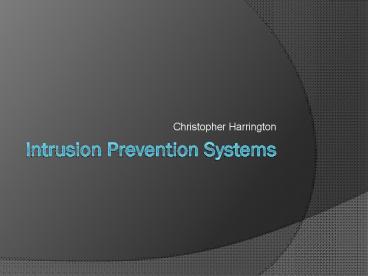Intrusion Prevention Systems - PowerPoint PPT Presentation
1 / 26
Title:
Intrusion Prevention Systems
Description:
McAfee. Hybrid Pro's & Con's. Pro's. Superior protection for both known and Zero Day threats ... TippingPoint, Top Layer, McAfee. Software Pro's & Con's. Pro's ... – PowerPoint PPT presentation
Number of Views:2674
Avg rating:3.0/5.0
Title: Intrusion Prevention Systems
1
Intrusion Prevention Systems
- Christopher Harrington
2
What is IPS?
- Intrusion Prevention System
- A system located on the network that monitors the
network for issues like security threats and
policy violations, then takes corrective action. - While there are both Host and Network based IPS,
term is usually associated with Network based
IPS.
3
What can an IPS do?
- IPS can detect and block
- OS, Web and database attacks
- Spyware / Malware
- Instant Messenger
- Peer to Peer (P2P)
- Worm propagation
- Critical outbound data loss (data leakage)
4
IPS Types
- IPS can be grouped into 3 categories
- Signature Based
- Anomaly Based (NBAD)
- Hybrid
5
Signature Based
- Use pattern matching to detect malicious or
otherwise restricted packets on the network - Sample signature
- alert tcp EXTERNAL_NET any - HOME_NET 8
(msg"BLEEDING-EDGE CURRENT Possible W32.Nugache
P2P Botnet Communication INBOUND Initial Packet"
flowestablished,to_server dsize
content"00 02" offset0 depth2
classtypetrojan-activity referenceurl,www.sarc.
com/avcenter/venc/data/w32.nugache.a_at_mm.html r
rev3)
6
Signature Based Products
- Sourcefire / Snort
- StillSecure
- NFR
- Cisco
7
Signature Pros Cons
- Pros
- Very flexible.
- Well suited to detect single packet attacks like
SQL Slammer. - Cons
- Relatively little Zero Day protection.
- Generally requires that the attack is known
before a signature can be written.
8
Anomaly Based
- Anomaly based IPS look for deviations or changes
from previously measured behavior like - Substantial increase in outbound SMTP traffic
- Existence of IRC communications where there was
none before - New open ports or services
9
Anomaly Based Products
- Mazu Networks
- Arbor Networks
- Q1 Labs
- Top Layer
10
Anomaly Pros Cons
- Pros
- Better protection against Zero Day threats
- Better detection of low and slow attacks
- Cons
- Cannot protect against single packet attacks like
SQL slammer - Cannot analyze packets at layers 5 7 of the OSI
model
11
Hybrid IPS
- Hybrid IPS combine Signature Based IPS and
Anomaly Based IPS into a single device
12
Hybrid Products
- Juniper
- NitroSecurity
- TippingPoint
- McAfee
13
Hybrid Pros Cons
- Pros
- Superior protection for both known and Zero Day
threats - Each plays off the weakness of the other
- Cons
- Generally more expensive than either Anomaly or
Signature based products - Can be slower depending on architecture
14
Architecture Software vs. Hardware
- Software based
- Generally runs Linux or a BSD variant
- EG Snort / Sourcefire, NitroSecurity,
StillSecure - Hardware based
- Uses ASIC / FPGA technology
- EG TippingPoint, Top Layer, McAfee
15
Software Pros Cons
- Pros
- More flexible
- Generally easier to add major functionality
- Cheaper
- Generally has more functionality
- Cons
- Usually slower than hardware
- Latency is usually higher than hardware
16
Hardware Pros Cons
- Pros
- Speed, Speed, Speed
- Lower latency than software
- Less moving parts to fail
- Cons
- Expensive
- Not easily upgradeable
- Major upgrades usually mean new ASIC chips
17
What about UTM?
- Unified Threat Manager
- All-in-one devices that can do
- Firewall
- Antivirus
- IPS
- VPN
- Etc.
- This is being discussed because vendors
- very often push UTM devices when
- customers are looking for IPS solutions
18
UTM Products
- Fortinet
- Radware
- Cisco (ASA appliance)
- Juniper
19
UTM Pros Cons
- Pros
- Cost effective for remote branch offices where
other capabilities like Firewall are also needed - Cons
- Usually a limited subset of IPS functionality and
signatures as compared to stand alone IPS products
20
Thinking about an IPS?
- Why?
- What problem are you trying to solve?
- What other problems may be solved?
- What problems may arise?
- If Networking is a different group than Security,
do you have their buy in?
21
Tips when selecting an IPS
- Prepare an RFP
- You can get a sample one from eWeek
- Do an on-site eval of your top choices
- Its vital to see how the device works in your
network. - Make sure you test their support, especially if
you are going to buy 24x7 - Look for products certifications
- ICSA, NSS Group, Neohapsis
22
What to consider when buying
- Speed / latency
- Will the device perform under load?
- Is the latency acceptable?
- Very important if you have VOIP!
- Accuracy
- How many attacks did it miss?
- How many false attacks did it block?
- Signature Updates
- Absolutely critical. How often the signatures are
updated is a key indicator of how serious they
are about selling IPS - High Availability
- Will it do Active-Passive, Active-Active?
- "Fail Open
- Will the device pass traffic in the event of a
device failure?
23
IPS Testing and Certifications
- Testing certifications are done by
- ICSA Labs
- NSS Group
- Neohapsis
- ICSA is the newest
- NSS is arguably the most respected, for now.
- The IPS should have at least one certification
24
Where is IPS going?
- Commoditizing
- IPS Functionality in Switches
- EG. Foundry, Consentry
- Can do IPS per port
- Network Access Control
- Post-connect NAC
- Agentless NAC
25
Questions?
26
Thank You































